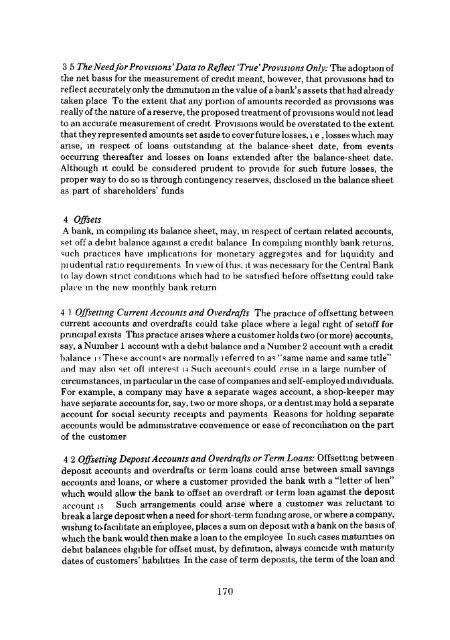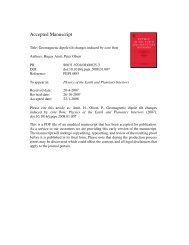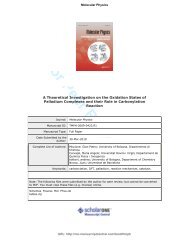parti: objectives and features of the new reporting system 159 - TARA
parti: objectives and features of the new reporting system 159 - TARA
parti: objectives and features of the new reporting system 159 - TARA
Create successful ePaper yourself
Turn your PDF publications into a flip-book with our unique Google optimized e-Paper software.
3 5 The Need for Provisions'Data to Reflect 'True' Provisions Only: The adoption <strong>of</strong><br />
<strong>the</strong> net basis for <strong>the</strong> measurement <strong>of</strong> credit meant, however, that provisions had to<br />
reflect accurately only <strong>the</strong> diminution m <strong>the</strong> value <strong>of</strong> a bank's assets that had already<br />
taken place To <strong>the</strong> extent that any portion <strong>of</strong> amounts recorded as provisions was<br />
really <strong>of</strong> <strong>the</strong> nature <strong>of</strong> a reserve, <strong>the</strong> proposed treatment <strong>of</strong> provisions would not lead<br />
to an accurate measurement <strong>of</strong> credit Provisions would be overstated to <strong>the</strong> extent<br />
that <strong>the</strong>y represented amounts set aside to cover future losses, 1 e , losses which may<br />
arise, in respect <strong>of</strong> loans outst<strong>and</strong>ing at <strong>the</strong> balance-sheet date, from events<br />
occurring <strong>the</strong>reafter <strong>and</strong> losses on loans extended after <strong>the</strong> balance-sheet date.<br />
Although it could be considered prudent to provide for such future losses, <strong>the</strong><br />
proper way to do so is through contingency reserves, disclosed m <strong>the</strong> balance sheet<br />
as part <strong>of</strong> shareholders' funds<br />
4 Offsets<br />
A bank, in compiling its balance sheet, may, in respect <strong>of</strong> certain related accounts,<br />
set <strong>of</strong>f a debit balance against a credit balance In compiling monthly bank returns,<br />
such practices have implications for monetary aggregates <strong>and</strong> for liquidity <strong>and</strong><br />
pi udential ratio requirements In view <strong>of</strong> this, it was necessary for <strong>the</strong> Central Bank<br />
to lay down strict conditions which had to be satisfied before <strong>of</strong>fsetting could take<br />
place in <strong>the</strong> <strong>new</strong> monthly bank return<br />
4 1 Offsetting Current Accounts <strong>and</strong> Overdrafts The practice <strong>of</strong> <strong>of</strong>fsetting between<br />
current accounts <strong>and</strong> overdrafts could take place where a legal right <strong>of</strong> set<strong>of</strong>f for<br />
principal exists This practice arises where a customer holds two (or more) accounts,<br />
say, a Number 1 account with a debit balance <strong>and</strong> a Number 2 account with a credit<br />
balance i \ These accounts are normally leferred to as "same name <strong>and</strong> same title"<br />
<strong>and</strong> may also set <strong>of</strong>f interest u Such accounts could prise in a large number <strong>of</strong><br />
circumstances, in <strong>parti</strong>cular in <strong>the</strong> case <strong>of</strong> companies <strong>and</strong> self-employed individuals.<br />
For example, a company may have a separate wages account, a shop-keeper may<br />
have separate accounts for, say, two or more shops, or a dentist may hold a separate<br />
account for social security receipts <strong>and</strong> payments Reasons for holding separate<br />
accounts would be administrative convenience or ease <strong>of</strong> reconciliation on <strong>the</strong> part<br />
<strong>of</strong> <strong>the</strong> customer<br />
4 2 Offsetting Deposit Accounts <strong>and</strong> Overdrafts or Term Loans: Offsetting between<br />
deposit accounts <strong>and</strong> overdrafts or term loans could arise between small savings<br />
accounts <strong>and</strong> loans, or where a customer provided <strong>the</strong> bank with a "letter <strong>of</strong> hen"<br />
which would allow <strong>the</strong> bank to <strong>of</strong>fset an overdraft or term loan against <strong>the</strong> deposit<br />
account 15 Such arrangements could arise where a customer was reluctant to<br />
break a large deposit when a need for short-term funding arose, or where a company,<br />
wishing tafacihtate an employee, places a sum on deposit with a bank on <strong>the</strong> basis <strong>of</strong>,<br />
which <strong>the</strong> bank would <strong>the</strong>n make a loan to <strong>the</strong> employee In such cases maturities on<br />
debit balances eligible for <strong>of</strong>fset must, by definition, always coincide with maturity<br />
dates <strong>of</strong> customers' liabilities In <strong>the</strong> case <strong>of</strong> term deposits, <strong>the</strong> term <strong>of</strong> <strong>the</strong> loan <strong>and</strong><br />
170
















